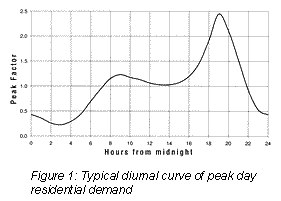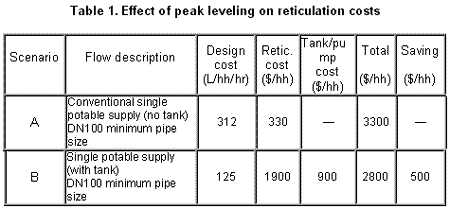Part 6: Peak leveling in urban water reticulation systems

CSIRO Urban Water is investigating the use of storage tanks located on residential properties to effect peak leveling of demand, and thus achieve substantial cost savings in the reticulation system.
By R.J. Shipton, CSIRO Building, Construction and Engineering
Editor's note: To follow is part six of a nine-part series of articles written by Australia's Commonwealth Scientific and Industrial Research Organization (CSIRO), a research organization supporting Australia's industry needs. CSIRO Urban Water recently undertook a major research project designed to thoroughly investigate the nation's water supply. The series will address research results with implications for urban water supply on a global scale.
Contents
Cost advantage of using peak-leveling tanks
Mechanism for peak leveling
Discussion
Australia's water supply series
The demand for water in urban supply systems is continuous and constantly changing. The largest component of use is normally residential, for which rates of demand vary seasonally throughout the year. Demand ranges from low during cool wet periods to high during hot dry periods with occasional very high peaks caused by garden and lawn watering.
Conventional reticulation systems are designed to meet the peak instant or peak hourly rate of demand at the end of the design period. A typical diurnal design curve of peak day residential use for a medium to large system is shown in Figure 1. The peak instant demand is 2.5 times the average rate for the peak day.

The cost of the reticulation system required to deliver water is highest when the capacity of the network is based on the peak instant rate, and would be significantly lower if based on the average rate. This reduction in design rate could be achieved using a small pump on each property with a storage tank with sufficient balancing storage. This means that the pipes for new systems need not be as large and that retro-fitting tanks into existing systems would allow substantial expansion into fringe areas without having to upgrade the existing tailworks system. However, the additional costs for the tank, pump and associated pipes and fittings must be added.
Cost advantage of using peak-leveling tanks
The following example compares the alternatives of providing single-pipe reticulation systems with and without peak-leveling tanks. The minimum pipe size for these systems is DN100 to provide a fire protection system based on street hydrants at about 100 m spacing (Water Reticulation Code of Australia (WSA 03-1999), Part 1 – Design, Water Services Association of Australia, 1999).
For a typical design value for peak day residential consumption of 3000 liters per household per day (L/hh/d), the peak instant design rate for the conventional system would be 3000 x 2.5/24 = 312 L/hh/hr (Scenario A). A reticulation system supplying peak leveling tanks with the same DN100 lower limit on pipe size would have a design demand of 3000/24 = 125 L/hh/hr (Scenario B) (Back to top).
Mechanism for peak leveling
The peak day demand of each household for in-house and ex-house uses is met from the tank, which is trickle-filled from the reticulation system at a steady rate throughout the day. The net effect of on-site storage is to reduce the peak flow design rate for the reticulation system by about 60%, i.e. from a peak factor of 2.5 to 1.0. A schematic showing a typical tank and pump arrangement for a single-pipe supply of potable water for all uses is shown in

The cost analysis (Table 1) is based on supplying water services to a cluster of 4000 households in an area of 3 km x 1 km using PN16 class PE pipes. The potable water source was assumed to be a service reservoir located some distance from the cluster, with a supply head such that a head gradient of about 4 m per 1000 m could be assumed for the distribution and reticulation mains for peak demand conditions. Using a computer program for hydraulic analysis of water supply networks, the pipe sizes were determined to ensure, at peak demand, a minimum residual head of 15 m (150 kPa) at the lowest pressure node within the cluster.

The tank and pump module has an estimated capital cost of $530, an annual cost of $62 including running costs, and an equivalent net present value of $900 using an effective discount rate of 7% per annum.
The analysis shows up a significant cost saving of $500/hh or 15% for the peak-leveled system supplying 4000 houses, assuming the installation is based on using standard trenching in sandy soil. (Back to top)
Discussion
Further research is proposed to study the impact of peak leveling for other situations. It is to be expected that the savings will become greater as cluster size increases, because whereas tank and pump costs are fixed, distribution costs are higher, particularly when ground conditions are difficult.
The cost benefit of retrofitting tanks into existing systems to permit network expansion into fringe areas has considerable potential. The new fringe area extensions would supply properties using peak-leveling tanks, however, the pipe sizes could be limited to a minimum of DN100 with street hydrants fitted, or have no minimum pipe size limit and incorporate alternative arrangements for residential fire protection. Additional savings could be made if a pressure reduction strategy was adopted for fringe area extensions that enabled the use of lower pressure class pipes.
The application of tanks to dual-pipe systems may also be cost effective, particularly if linked to the non-potable lawn and garden watering supply. (Back to top)
About the author: By R.J. Shipton is with CSIRO Building, Construction and Engineering . For more information on CSIRO, visit their website at http://www.dbce.csiro.au. (Back)
Australia's water supply series
Part 1: An introduction to Australia's water supply
Part 2: Life cycle costing of urban water systems
Part 3: Urban Volume and Quality, a water and contaminant balance model
Part 4: TAWS: Tools for Assessing Alternative Water Systems
Part 5: The scenario manager
Part 6: Peak leveling in urban water reticulation systems
Part 7: Peak load management at wastewater treatment plants
Part 8: Economic scale of graywater reuse systems
Part 9: Septic tank replacement
(Back to top)
This article appeared in the December 2000, Number 16, edition of Innovations, a bimonthly online magazine "showcasing new technology, products and services impacting on Australia's built environment."
